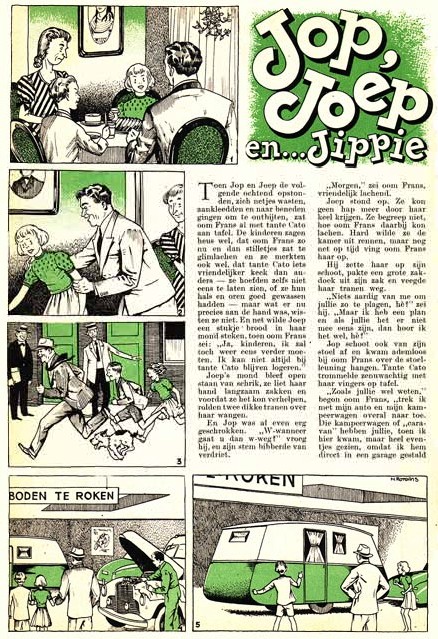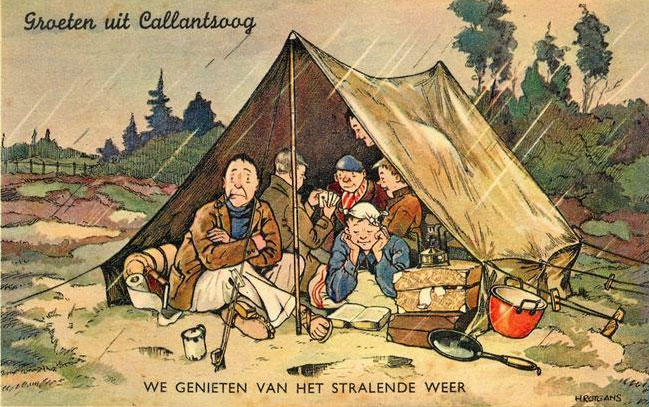Henk Rotgans, often referred to as H.J. Rotgans, was a Dutch illustrator, photographer and comic artist. From the 1930s through the 1960s, he worked extensively for the magazines published by De Spaarnestad, such as De Humorist, Panorama, Libelle and Sjors. Among his comics were the first promotional booklets with the character 'Flipje' for jam factory De Betuwe, some heavily illustrated serials in Libelle and adaptations of classic literary works for Sjors. He was also a productive illustrator of humorous postcards.
Early life
Hendricus Jacobus Rotgans was born in 1910 in the northern district of Amsterdam. His father, the illustrator and graphic designer Jan Rotgans (1881-1969), passed on his artistic talents to his son. During secondary school, Henk Rotgans' drawing capabilities were noticed, and, between 1931 and 1934, he subsequently attended the Amsterdam Institute of Applied Arts ("Kunstnijverheidsschool", nowadays the Rietveld Academy), studying graphic arts.
Advertising illustration for 'Flipje' and cover illustration voor Wij Voor Onze Jongens en Meisjes, 3 December 1937.
Early career
After graduation, in 1935, Rotgans began his enduring collaboration with the publishing house De Spaarnestad in Haarlem. He made many drawings and illustrations for the company's humor magazine De Humorist, but also for the weekly Panorama. Around the same period, he succeeded Daan Hoeksema as the artist of advertising booklets for jam factory De Betuwe in Tiel. Rotgans was the first to draw adventures starring the factory's little fruit mascot with chef's hat, 'Flipje' (1935). While Flipje was originally created by the Van Alfen advertising agency, it was Rotgans who gave the little raspberry man a monkey friend in red shorts, later known as Jasper. After four booklets, Rotgans passed the pencil to Eelco Harmsen van Beek and his wife Freddie Langeler, who gave the character and his magical environment their definitive shape.
By 1937, Rotgans' art also appeared in the children's supplement of the socialist weekly Wij of publisher De Arbeiderspers, called "Wij Voor Onze Meisjes en Jongens". He also illustrated series of storybook themed postcards, such as the Pinocchio-inspired 'De Reis van Houtepiet' (1939), the funny animal series 'Een Dwaze Valpartij' (1939) and the fairy tale 'Lolinde en de Booze Dwergen' (1939). During the mobilization in the prelude to World War II, Rotgans made a series of postcards with military humor for publisher J.H. Schutte Jr. in Amsterdam.
Postcard from the series 'Lolide en de Booze Dwergen'.
World War II
Being mobilized himself shortly afterwards, Rotgans was stationed as a sergeant in Soestdijk, Utrecht, in the center of the country. After the Dutch capitulation, he returned to Amsterdam, but in June 1943, he went into hiding in the Noordoostpolder region to avoid being sent to Nazi Germany for forced labor. The polder had been fully drained in 1942, and was being prepared for habitation. Rotgans was assigned to paint murals in the workers' barracks, and also documented the construction of the new Dutch territory in many sketches. While in hiding, in 1944 Rotgans also received his drawing teacher certificate from the Normaalschool in Amsterdam.
'Jop, Joep en Jippie'.
De Spaarnestad
After World War II, Rotgans settled in Amsterdam's Watergraafsmeer district and later in Bussum, while resuming his activities for De Spaarnestad. He became a productive illustrator for the women's weekly Libelle. Among his contributions were the serials 'Robbie en Ringo' (1951-1952), 'Jop, Joep en... Jippie' (1952-1953), 'Moppy Mal' (1955-1956) and 'De Razende Raket' (1960-1961), which can all be considered hybrids between text comics and illustrated stories. He also made several cover drawings for Libelle's children's supplement Tombola, as well as the illustrations for the Toon Kortooms serial 'De Heldendaden van Prins Panter' (1954). In 1952, De Spaarnestad published 'Robbie en Ringo', about the adventures of a boy and a giant, in book format.
'De Schipbreukelingen' (Sjors, 1 May 1965).
During the 1950s, Rotgans served as one of the most prominent illustrators for De Spaarnestad's children's publications, along with Boy ten Hove, Frans Piët, Hans Ducro, Jan Giling, Piet Broos, Mies Deinum, Nico van Dam and Bert Bus. Apart from Tombola, he also illustrated text stories in Rebellenclub and Grabbelton, the semi-identical children's supplements of Panorama and Katholieke Illustratie. He was additionally present in Rebellenclub's successor, the comic magazine Sjors, launched in 1954. He illustrated new text stories, and later made heavily captioned comic adaptations of the literary classics 'Treasure Island' ('Schateiland', 1963-1964), 'Swiss Family Robinson' ('De Schipbreukelingen', 1965), and 'The Prince and the Pauper' ('De Prins en de Bedelaar', 1966-1967).
'De Prins en de Bedelaar' (1967).
Postcards
From the late 1940s until the early 1960s, Rotgans illustrated many humorous holiday postcards, depicting camping situations, transportation issues and Dutch towns. The publisher was presumably Mes en Bronkhost. Rotgans additionally made a new series of postcards with military humor.
Callantsoog
From 1950 on, Rotgans and his wife Hans lived in the coastal town of Callantsoog, where they ran the health food store De Koets and rented out their house to German tourists. The store also sold many of Rotgans' postcards with photos and drawings of the town. Rotgans' photographs of Callantsoog were also published in the local paper Badbode voor Callantsoog.
Final years and death
Later in life, Henk Rotgans was the author of the guidebook 'Ruimtelijk Tekenen' (Cantecleer, 1984), in which the author explains the rules of drawing perspective. The book was translated into German, French, Spanish and Slovenian. Henk J. Rotgans passed away in Callantsoog in 1989.
Postcard by Henk Rotgans. The caption reads: "We're enjoying the sunny weather."










